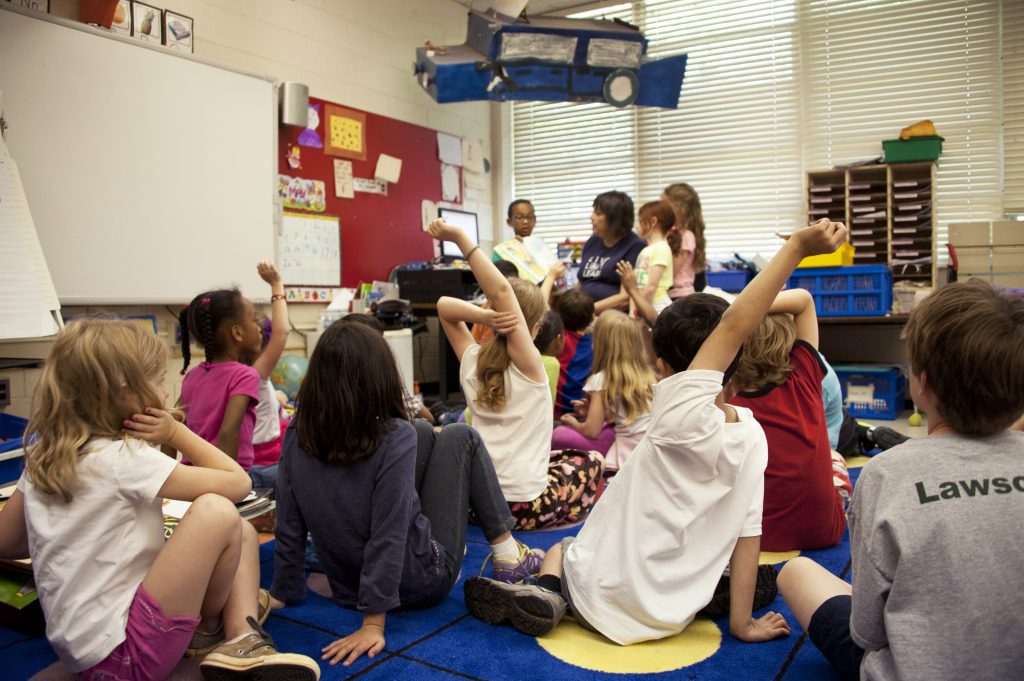Simple Steps To Raising Money-Savvy Kids

Did you know that children’s financial habits are set by the age of seven? They also start picking up on money concepts as young as three! The habits they emulate come almost entirely from parents and grandparents. It’s true! Money management is a learned behavior, so the earlier you focus on educating children, the better. 
Here are seven tips for getting started at any age:
Set a good example. Your children listen to everything you say and do! Stay positive toward money and be conservative with your spending.
Encourage a habit of saving. Spending habits are obvious, but the act of saving is typically invisible. Teach through intentional and frequent conversations about your saving goals. Let them set and reach saving goals themselves.
Present money-making opportunities. People place more value on the money they’ve had to work for than the money they’ve been given. Providing an allowance in exchange for chores or encouraging earning from odd jobs provides an opportunity to comprehend the value of hard-earned money while learning the power of saving.
Promote smart spending using budgets. Budgets help create a clear distinction between needs and wants. Work with your kids to show them how impulse spending can impact both their budget and their savings’ growth potential.
Educate them on how money grows. Teach your children about compound interest. Bank that allowance and help them see their money grow!
Parents and grandparents have an important role in passing along good financial habits and advice to children. The time to get started, no matter the age is now!

Money Concepts You Can Teach Preschoolers
Financial education is an important topic to introduce to kids, even those as young as preschool. Building a positive relationship with money when kids are young will go a long way toward their future success. The end goal is to develop financial literacy skills early and keep improving those skills throughout their youth.
Here are four simple ways to get even the littlest kids familiar with money:
 Count coins. Preschool is the perfect age to have kids sort and count coins. Explain that each coin looks different because each holds a different value. Here’s an idea: set up a little grocery store and have them purchase food with their coins. Practice counting out more coins for big purchases and less for small ones.
Count coins. Preschool is the perfect age to have kids sort and count coins. Explain that each coin looks different because each holds a different value. Here’s an idea: set up a little grocery store and have them purchase food with their coins. Practice counting out more coins for big purchases and less for small ones.
Teach the value of money. Communicating the cost of items in stores will open their eyes to associating things with worth and instill a habit of checking prices. Take them on shopping trips, show them where prices are located, and tell them the cost of each item as you put it in the cart. Have them watch the total cost increase as items are scanned at checkout and hand the money to the cashier.
Tell stories. All kids love stories! Tell them about the price differences of candy and toys from when you were a kid. Talk about your first job, what you were paid and how much your bills were. Tell them about a financial hardship you went through and how you managed to overcome it.
Read together. There are many great children’s books about money. Take them on an adventure to your local library to borrow (instead of purchase) books about saving, spending, and wants vs. needs.
Use these basic lessons and discussions very early on to help your kids build a relationship with money. Get started now so you can give them the gift of being a money-savvy adult someday. That’s truly priceless!
3 Money Truths to Introduce to Kindergarteners
You may think the concept of money is too complex for kindergarteners to understand, but you’d be surprised how quickly they pick it up through games and playful experiences! Promoting valuable money skills at a young age can put kids at a big advantage when it comes time for them to manage money independently. 
Since most kindergarteners can grasp the value of money and how it’s exchanged for goods and services, these three truths are a good starting point for this age group:
Money doesn’t grow on trees. Most transactions that kids see are done using the swipe of a credit card. Teach them that cards don’t offer unlimited money, and you can’t spend more money than you have. Pay with cash when you can, so they see the physical exchange for goods and services. As an activity, send them down a snack aisle with $10. Show them where the prices are and help them figure out exactly what $10 will buy.
Needs vs. wants. Teach them that needs are things they can’t live without and wants is everything else. Being able to know the difference is a skill that’ll benefit them throughout adulthood. Try thinking out loud when shopping. Point out things you want vs. need. Quiz them by asking which category an item falls into at stores or on commercials while watching TV.
The power of delayed gratification. Teach kids to wait for what they really want. Most successful adults say they were taught this at a young age, and it has helped them live within their means and avoid debt. Have your child pick out a small toy to save for. Create a goal chart with the number of days it’ll take to earn enough allowance to afford the toy. Color in the days as they pass to visualize progress.
There are other simple ways to teach kids about money. Introducing these three concepts is a great way to begin building their healthy money management habit!
Elementary Money Education for Kiddos

For kids in the 7 to 10 age range, use tangible lessons built on tried and true processes. Here are three that work well together and offer some of the greatest overall benefits for elementary-aged children:
Start an allowance. Introduce a weekly allowance for chores around the house. This weekly income will encourage good money management, budgeting, and saving habits. Give them opportunities to earn more money for doing extra work to instill the concept that working more pays more.
Implement the ‘three jars’ system. This system is great for illustrating the concepts of saving and giving for kids. Label three clear jars: save, spend and share. Have kids decide what portion of their allowance goes into each jar. The money put into the ‘save jar’ is for large items, such as toys or events. The money in the ‘spend jar’ goes toward discretionary spending. And the money in the ‘share jar’ goes toward a charity of their choice.
Open a savings account. Research banks together! Find the one with the highest interest rate and explain how compound interest impacts a balance over time. Then, make an event out of opening their first savings account. Take weekly or monthly bank trips with them to deposit their ‘save jar’ cash so they can watch the balance grow over time.
These lessons will teach children that budgeting and patience can help their money go much farther. If you instill habits like these at a young age, they’ll become second nature for them as adults. Try these three and let us know how they go!
Adulting Pre-Work for Preteens
Most kids between the ages of 10 and 13 understand how money works, even if it seems like an uphill battle to get them off the couch and earn it. Entrepreneurial kids may even be searching for ways to earn extra cash. While earning great, it’s equally important for them to know how to spend and save.
Here are three real-world lessons to further prepare pre-teens to be good money managers:
Encourage side gigs. As kids get older, they want new ways to earn more than just their allowance. Encourage them to ask neighbors for jobs, like mowing lawns and babysitting. Communicate that people willing to work more often earn more. Try this: help them make a jobs flyer, then go door-to-door with them to hand them out. When they earn extra cash, help them decide how much to save, spend and give.
Teach comparison shopping. Teach them how to save while spending by comparing costs of goods at different stores. Show them that generic versions are sold at a fraction of the cost. Smart shopping will save them thousands throughout their lifetime. As an activity, take them shopping at your grocery store for the items used in their favorite recipe and price the ingredients using popular brand-name products. Then, price those same ingredients using the store brand products and compare costs. 
Teach budgeting. As kids grow, so do their needs for things like clothes, school supplies, and sporting equipment. Teach pre-teens the importance of meeting their needs by creating a budget and learning how to stick to it. As an activity, determine what your child needs for the sports season. If it’s baseball, budget for a bat, cleats, and a glove. Then illustrate the price differences by walking them through what it costs to purchase each item new from a retail store versus gently used from a second-hand resource. Since these are typically growth-spurt years, help them also understand why it may be difficult to use the full value of a new, expensive item if it only fits for one season.
Start teaching your kids the value of every dollar through hard work and real-life transactions, and you’ll help them realize how every dollar saved can impact their future.
Activities To Raise A Financially-Independent Adult
Teaching teens good money habits can be frustrating at times because, as you know, they already know everything there is to know. Since most will have part-time jobs and shopping experience, look for real-world teachable moments to fine-tune those concepts you’ve already taught them. Introduce new activities to further enhance their money management skills.
Here are four more to consider for young teens:
Automate their savings. Show teens how to set up automatic transfers from their checking to their savings account to encourage a habit of setting aside a portion of their paychecks to ‘pay themselves first.
Emphasize the importance of good credit. Many big-ticket items require a credit score check, a reflection of their financial trustworthiness. Purchases like a car or their first home both require them to have a history of good credit to receive a reasonable loan rate. Show them how to check their credit, and advise them to do it once a year to look for fraudulent activity.
Discourage the use of credit cards. Teach teens that credit cards allow you to borrow money, but the cost to borrow is very high (particularly for new accounts!). Explain that this is the worst kind of debt to carry over month-over-month. The best way to handle a credit card is to pay it off each month! 
Encourage the use of debit cards. Start them off with a debit card that comes preloaded with a set dollar amount or one that’s connected to your bank account with parental controls. Both types are great for learning how to budget and track expenses without the risk of going into debt or destroying their credit.
Prepare them for college costs. Ensure they understand the true cost of the college degree they want, and help them research ways to make it financially possible. Encourage them to get a job to help pay and apply for grants and scholarships. Take them to local college fairs to compare tuition costs between four-year and two-year schools. Be transparent about the burden of student loan debt.
Enforce tips like these now to help ensure your young teen turns into a well-rounded adult when it comes to managing their finances.
